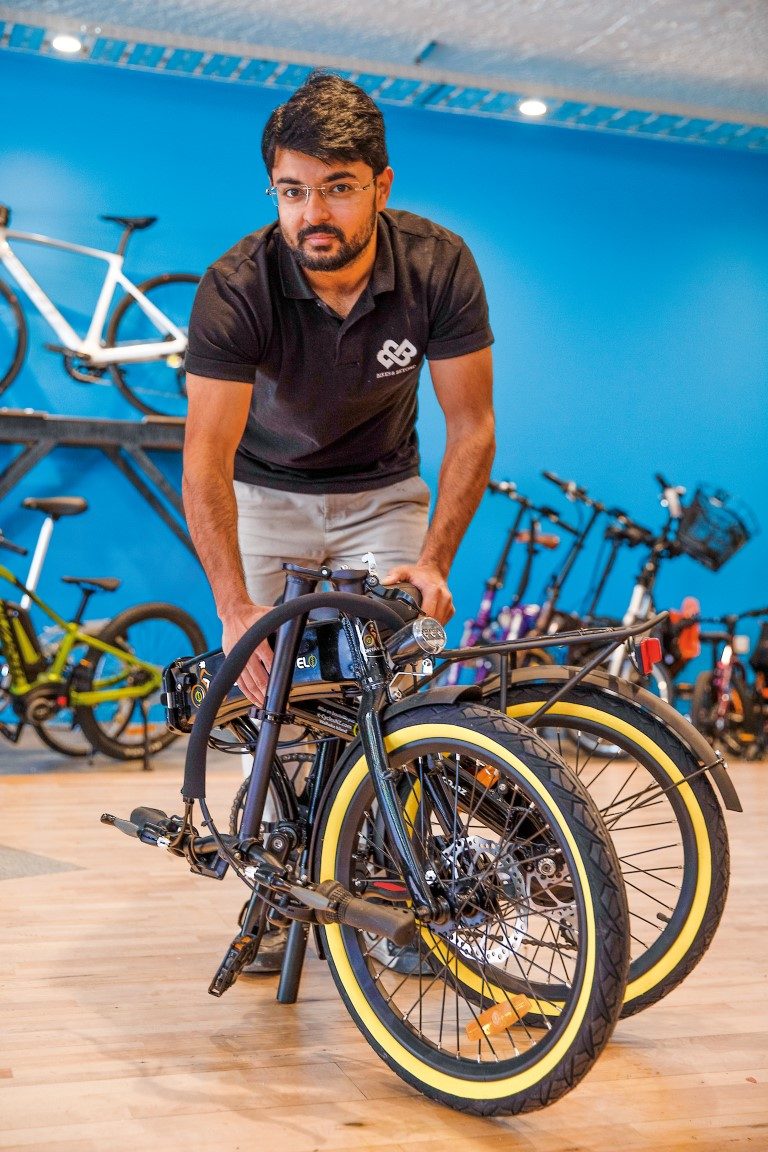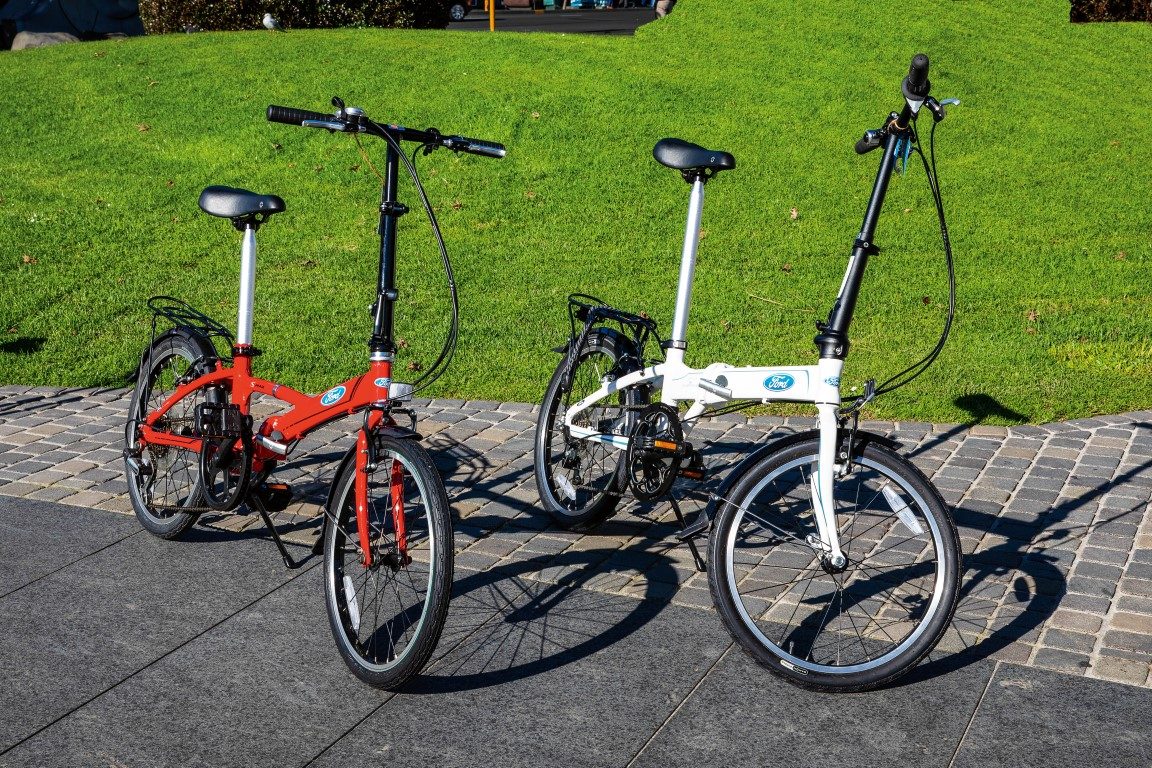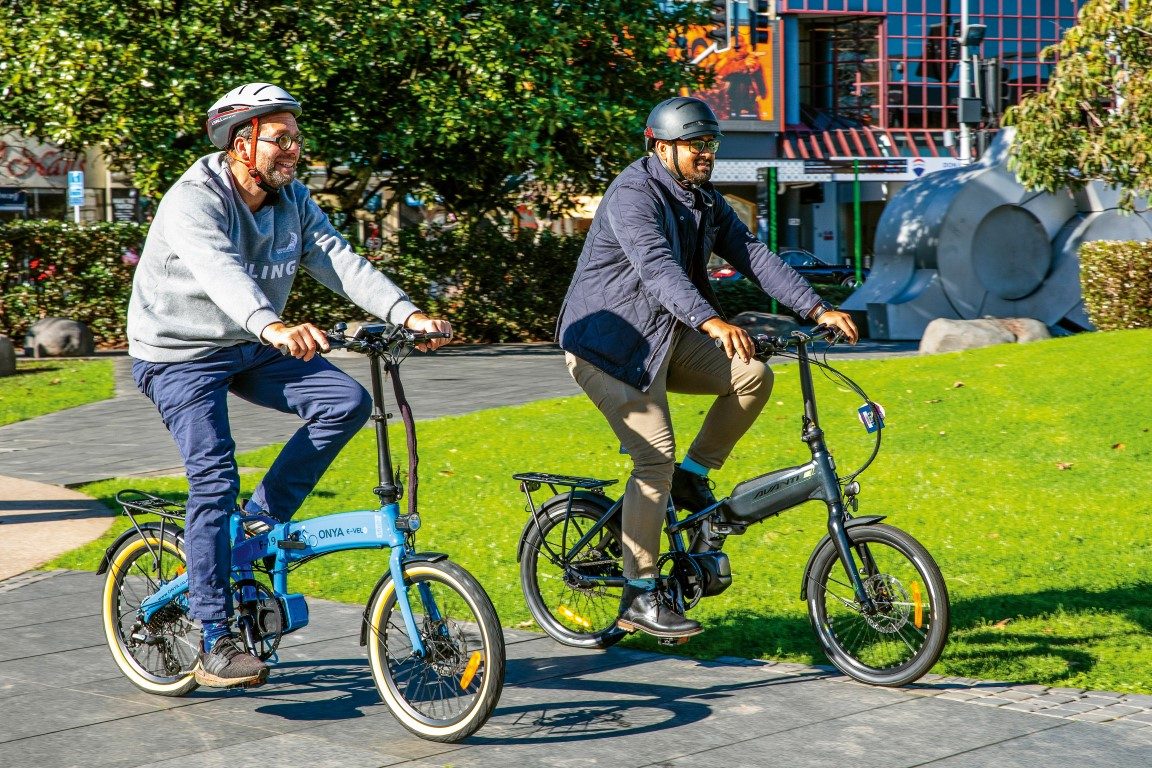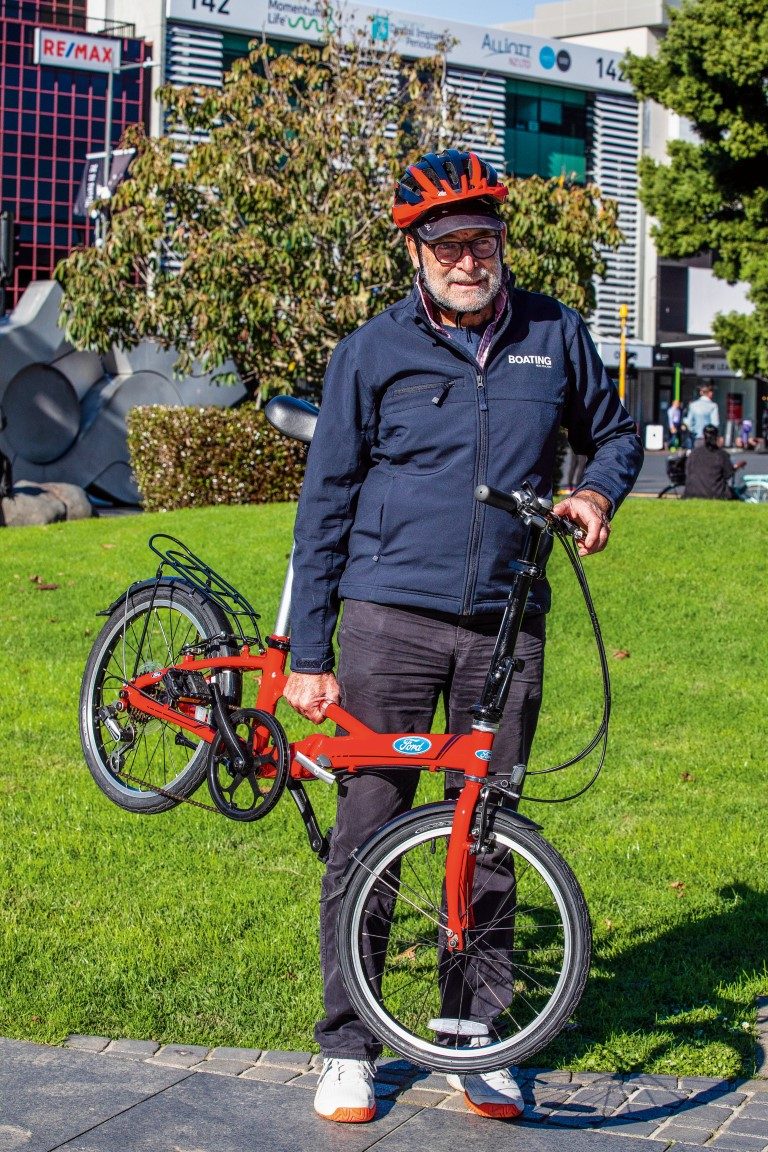

Ironically, one of the great joys of cruising is getting off the boat for a stroll on land. Especially after a long trip. But, equally ironically, these shore-side walks themselves often feel too long. Too much like hard work. You need wheels – ideally electric-assisted. Story by Alex Stone, photos by Lesley Stone.
Walking on land is not as effortless as sliding splendidly along under sail, or sitting at ease on your launch’s skipper’s chair. So it’s a good idea for cruising yachts and launches to have a pair (or two) of wheels aboard. But how to stow them while at sea? Where to find good models?
Though folding bikes have become a common part of a cruising yacht’s inventory, they haven’t always been efficient or handy.
For one thing, just about every bicycle I’ve seen on boats was rusted. Badly. Rust-dust and boat interiors don’t go well together. Also, bikes on boats have tended to be tricky to unfold, or awkward to ride, with their small wheels providing less gyroscopic stability.

The new generation of folding bikes addresses these concerns. And what’s more, there’s a surprisingly large range – with attendant price-tags – to choose from. You’re looking at anything from $500 to $5,000 – depending on how much you want to pedal.
Just about all folding bikes are now made with aluminium alloy frames, or other non-rusting materials, to save weight. And they all now have stainless steel chains. An expected innovation is a carbon belt drive, coming soon to the bike market. This will probably add around $600 to $700 to the average price of an e-bike.
So the rust thing is mostly taken care of. Plus, there’s now the electric option. With or without pedals. Taking a stroll on land has suddenly been turned into a cornucopia of new options for adventure, with a far bigger capacity or ‘range’ thrown in.
Most electric bike batteries have a charge life of around three hours – and biking of this nature averages around 20km/h. Simple maths says you’re looking at an at-least 35 km range (there and back) for on-shore outings. Further – if you’re happy to go by pedal power alone.

So, where to find out more about folding bikes? I’d say it pays to start with a yachtie, an engineer, a bike designer, a man who rides a boat every day with bike in hand. He probably knows a thing or two about the practicalities of mixing bikes and boats and salt water spray.
Chris Hoff-Nielson is a German-educated automotive design engineer and previously worked as a mechanical designer for some of Europe’s major motor car marques. As part of his environmental ethos he’s made a progression to bikes, e-bikes and scooters.
Ironically, and simultaneously, he and the car industry are now merging with the marketing of bicycles. For example, at his three Bikes & Beyond outlets (Newmarket, Devonport and Waiheke Island), among the folding bikes on offer are those branded ‘Ford’. And if you’re still thinking gas-guzzling, Christian tells me that if you now buy a new-model Ford Mustang in the US, they’ll throw in a couple of the folding bikes as well!
Aluminium alloy folding bikes were pioneered in the 1970s by a San Francisco-based Japanese designer, Dr David Hon. He and his brother Henry started the Dahon company with their breakthrough folding bike – the first small enough to fit under a commuter train seat. The necessity that mothered this invention was David’s daily trips to university to complete his PhD, in the physics of ‘tactical lasers’ (not bicycles).

There’s now a range of 50 folding bikes of his design, including the specialised Marine D7. It can fold into a handy cloth bag with dimensions of 70 x 25 x 65cm. Bike & Beyond is the New Zealand distributor for Dahon bikes. The Marine D7 has an internal hub on the back wheel – no deraillieur needed (the hanging, changing-angle contraption for the chain to go around, that almost all geared bikes have).
Supporting Kiwi ingenuity is the added bonus of visiting Bikes & Beyond. Chris designs his own electric bikes – those of the Onya range. He was fortunate to gain the rights to build on the existing Dahon ‘frame geometry’ to convert to folding, and to electric auxiliary power.
Onya bikes are notable because they’re light (19kg), unisex and unisize. An intelligent design feature is that the handlebars and seat angle away from each other as they are adjusted upwards, thereby automatically allowing for taller people with longer arms, and vice versa.
Chris’ Onya designs are now licensed and marketed in 15 countries, including Belgium, Poland and Israel, with more being added.
An interesting design consideration, he says, is that there’s at least 6kg to be added to any electric-assisted bike design when converting it, or designing from scratch. This is made up of the electric motor and battery (66%), and from having to ‘beef-up’ other components to address additional loading (33%).
Interestingly, only about half of the folding bike market is made up of boaties and motorhome owners. The rest are generally of a younger demographic, buying these bikes to be able to carry them up to their offices or apartments. Most people, says Christian, budget around $2,000 to $3,000 for a good bike.

But you can start way lower. The pedal-powered (non electric-assisted) folding bikes start at $595 for the Dahon and Ford ranges, and go up to around $895. The more expensive ones appear to have a greater rigidity in the frame design.
The most popular folding e-bike at Bikes & Beyond is the Onya F-19. It costs $3,390 and will give you at least a 45km only-electric range. Chris’ first customer for these bikes was, in fact, a cruising yachting couple – they bought four.
If you do have more space aboard, you could go for the (non-folding) E-Vinci, a German design e-bike that sells for $2,240, with normal bike-sized wheels.
Here’s where the decision about smaller (for the folding bikes) or bigger wheels comes into play. Bigger-wheeled bikes are more stable. But, as Chris points out, the smaller-wheeled folding bikes are more manoeuvrable in tight situations – as many boaties find out, having to navigate marina pontoons and gates, and crowded pathways or boardwalks.
At the other end of the price range is the folding Avanti, a New Zealand-designed, Taiwanese-made (with a Japanese motor) e-bike that costs $5,299. It weighs 24kg, has a 75km (possible) electric range, with hydraulic brakes, all internal-routing of wiring, and no deraillieur – which means it’s easier to fold and lay down without damage.
Bike trips from boats often involve awkward luggage – or kid-carrying. For this Chris recommends the Tern HSD ‘Captain’s Chair’ design. This essentially has an extended pillion seat, capable of accomodating even three small children. It has fold-down handlebars, and costs $5,499.
The thing to look for in terms of efficiency for e-bikes, he says, is a mid-drive motor. That is, one working directly through the pedal hub. This amounts to a superior ability to climb hills.
What about charging your bike on-board the boat? Camping-style 12-volt chargers are freely-available. Putting out 150 watts, they cost a little over $100 and typically charge an e-bike battery in about three hours.

Scooters?
Electric scooters are now a ubiquitous part of the cityscape – and can be considered for boats, too. They are even smaller when folded up, and lighter. But, says Chris, scooters are generally designed for lighter riders of around 65kg. Some have a range of 40km, but long trips on a scooter can become uncomfortable – their quick-bouncy motion and the standing stance is unforgiving on the knees.
Also, there’s no space for luggage, unless you have a backpack. And unlike an electric bike, which you can still pedal, a scooter won’t get you back to the boat if the battery runs out.
Electric scooters start at a price of around $1,300.
The cleverest things at Chris’ shop are the new smart helmets – the Livall range just launched and marketed here by Sanchitt Mittal.
Your bike being nicked while you’re shopping is a perennial worry with boaties ashore in strange places. With a smart helmet linked to your e-bike or scooter, it will be locked and won’t go at all (not even pedalling), unless you and your smart helmet are astride it. There are 17 models of smart helmets, ranging in price from $99 to $249. Livall also does an electric scooter that lights up like a Christmas tree.
There are dozens of folding bikes and scooters to try out at at good bike shops around the country – too many to go into details of each in this brief overview. But rest assured alloy folding bikes are a very worthwhile addition to any cruising boat’s complement. Check them out.




